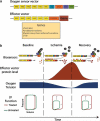Molecular cardiology in translation: gene, cell and chemical-based experimental therapeutics for the failing heart
- PMID: 19956787
- PMCID: PMC2759715
- DOI: 10.1007/s12265-008-9065-6
Molecular cardiology in translation: gene, cell and chemical-based experimental therapeutics for the failing heart
Abstract
Acquired and inherited diseases of the heart represent a major health care issue in this country and throughout the World. Clinical medicine has made important advancements in the past quarter century to enable several effective treatment regimes for cardiac patients. Nevertheless, it is apparent that even with the best care, current treatment strategies and therapeutics are inadequate for treating heart disease, leaving it arguably the most pressing health issue today. In this context it is important to seek new approaches to redress the functional deficits in failing myocardium. This review focuses on several recent gene, cell and chemical-based experimental therapeutics currently being developed in the laboratory for potential translation to patient care. For example, new advances in bio-sensing inducible gene expression systems offer the potential for designer cardio-protective proteins to be expressed only during hypoxia/ischemia in the heart. Stem cells continue to offer the promise of cardiac repair, and some recent advances are discussed here. In addition, discovery and applications of synthetic polymers are presented as a chemical-based strategy for acute and chronic treatment of diseased and failing cardiac tissue. Collectively, these approaches serve as the front lines in basic biomedical research, with an eye toward translation of these findings to clinically meaningful applications in cardiac disease.
Keywords: Cardiac; Heart; Translational.
Figures




Similar articles
-
Engineered Heart Repair.Clin Pharmacol Ther. 2017 Aug;102(2):197-199. doi: 10.1002/cpt.724. Epub 2017 Jun 29. Clin Pharmacol Ther. 2017. PMID: 28661033 Free PMC article. Review.
-
Human-based approaches to pharmacology and cardiology: an interdisciplinary and intersectorial workshop.Europace. 2016 Sep;18(9):1287-98. doi: 10.1093/europace/euv320. Epub 2015 Nov 29. Europace. 2016. PMID: 26622055 Free PMC article.
-
Novel targets and future strategies for acute cardioprotection: Position Paper of the European Society of Cardiology Working Group on Cellular Biology of the Heart.Cardiovasc Res. 2017 May 1;113(6):564-585. doi: 10.1093/cvr/cvx049. Cardiovasc Res. 2017. PMID: 28453734 Review.
-
ESC Working Group on Cellular Biology of the Heart: position paper for Cardiovascular Research: tissue engineering strategies combined with cell therapies for cardiac repair in ischaemic heart disease and heart failure.Cardiovasc Res. 2019 Mar 1;115(3):488-500. doi: 10.1093/cvr/cvz010. Cardiovasc Res. 2019. PMID: 30657875 Free PMC article. Review.
-
Meeting highlights from the 2013 European Society of Cardiology Heart Failure Association Winter Meeting on Translational Heart Failure Research.Eur J Heart Fail. 2014 Jan;16(1):6-14. doi: 10.1002/ejhf.10. Epub 2013 Dec 14. Eur J Heart Fail. 2014. PMID: 24453095 Review. No abstract available.
Cited by
-
Aesthetic cardiology: adipose-derived stem cells for myocardial repair.Curr Stem Cell Res Ther. 2010 Jun;5(2):145-52. doi: 10.2174/157488810791268654. Curr Stem Cell Res Ther. 2010. PMID: 19941452 Free PMC article. Review.
-
Myosin light chain phosphorylation is critical for adaptation to cardiac stress.Circulation. 2012 Nov 27;126(22):2575-88. doi: 10.1161/CIRCULATIONAHA.112.116202. Epub 2012 Oct 24. Circulation. 2012. PMID: 23095280 Free PMC article.
References
-
- Rosamond W, Flegal K, Friday G, Furie K, Go A, Greenlund K, Haase N, Ho M, Howard V, Kissela B, et al. Heart disease and stroke statistics—2007 update: a report from the American Heart Association Statistics Committee and Stroke Statistics Subcommittee. Circulation. 2007;115:e69–e171. - PubMed
-
- Thom T, Haase N, Rosamond W, Howard VJ, Rumsfeld J, Manolio T, Zheng ZJ, Flegal K, O'Donnell C, Kittner S, et al. Heart disease and stroke statistics—2006 update: a report from the American Heart Association Statistics Committee and Stroke Statistics Subcommittee. Circulation. 2006;113:e85–e151. - PubMed
-
- Tang Y, Schmitt-Ott K, Qian K, Kagiyama S, Phillips MI. Vigilant vectors: adeno-associated virus with a biosensor to switch on amplified therapeutic genes in specific tissues in life-threatening diseases. Methods. 2002;28:259–266. - PubMed
-
- Boast K, Binley K, Iqball S, Price T, Spearman H, Kingsman S, Kingsman A, Naylor S. Characterization of physiologically regulated vectors for the treatment of ischemic disease. Human Gene Therapy. 1999;10:2197–2208. - PubMed
Publication types
MeSH terms
Substances
Grants and funding
LinkOut - more resources
Full Text Sources
Medical
Miscellaneous
